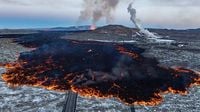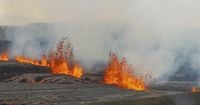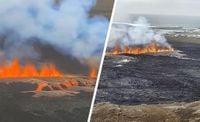On April 1, 2025, a significant volcanic eruption occurred in southwestern Iceland, specifically at the Sundhnúkur crater, prompting immediate evacuations in the surrounding areas. The eruption, which began shortly before 9:45 AM local time, followed a series of over 200 earthquakes that began around 6 AM, indicating increasing volcanic activity. This marks the eleventh eruption in this region since 2021, showcasing Iceland's ongoing geological volatility.
The town of Grindavík, which has a population of approximately 3,500 residents, is currently the most at risk. A half-kilometer-long fissure has opened nearby, spewing lava and raising alarms among local authorities. As a precaution, teams are on standby to build or reinforce existing protective barriers, and cooling the lava is under consideration to mitigate potential damage.
In a swift response to the escalating situation, authorities ordered the evacuation of 40 homes in Grindavík, as well as the popular Blue Lagoon spa, where around 200 people, including 150 tourists, were present at the time. The Icelandic Civil Defense has been proactive, sending out SMS alerts in Icelandic, English, and Polish, urging residents to evacuate and conserve electricity and hot water. One of the messages stated, "Evacuate, evacuate! Leave the area quickly and safely; call 112 if you need assistance." This has been a crucial communication tool for those in the affected areas.
Benedikt Ofeigsson from the Icelandic Institute of Meteorology noted that an eruption was the most likely scenario as they monitored the situation closely. Earlier on April 1, experts observed disturbing signals, and the series of earthquakes was unprecedented, with reports of around 200 tremors in the vicinity of Sundhnúk. The authorities are particularly concerned about the potential for a larger eruption this time, as the magma intrusion is longer than in previous events, leading to significant magma accumulation underground.
Despite the chaos surrounding the eruption, Keflavik International Airport continues to operate without disruptions, allowing for the safe transit of evacuees and other travelers. However, officials are keeping a close eye on air quality in Reykjavik, as wind patterns could lead to air contamination if the volcanic ash spreads towards the capital.
Historically, this area has experienced volcanic eruptions and seismic activity due to its location on the Mid-Atlantic Ridge, a hotspot for geological activity where tectonic plates diverge. The current eruption is part of a series of volcanic events that have plagued the region since March 2023, highlighting the unpredictable nature of Iceland's geology.
The Icelandic government is taking all necessary precautions to ensure public safety. The Minister of Infrastructure, Eyjólfur Ármannsson, has reassured residents that the Civil Defense is working diligently to manage the situation, including preparations to cool lava flows and strengthen defensive barriers. He urged the public to remain calm and follow instructions from police and emergency services.
As the situation develops, experts continue to monitor seismic activity and the progression of the lava flow. The Civil Defense has emphasized the importance of community cooperation during this time of crisis, urging residents to stay informed and adhere to safety guidelines.
This eruption is a stark reminder of Iceland's dual identity as a land of ice and fire, where natural beauty coexists with the potential for destructive geological events. The resilience of the Icelandic people will be tested once again as they navigate the challenges posed by this volcanic eruption.
In summary, the eruption at Sundhnúkur has led to significant evacuations and heightened alertness among residents and authorities alike. With ongoing monitoring and support from emergency services, the hope is to mitigate the impact of this natural disaster on the local community and its visitors.
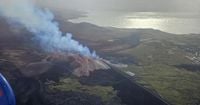
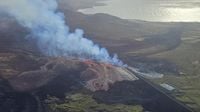
![Islandia. Wybuch wulkanu i ewakuacja. Odwołają loty? [WIDEO]](https://thumbor.evrimagaci.org/hJas5hLcyB0px3E671imWmGiRRU=/200x0/tpg%2Fsources%2F9a2f233b-954e-43b8-b6f0-e63e2d511460.jpeg)
